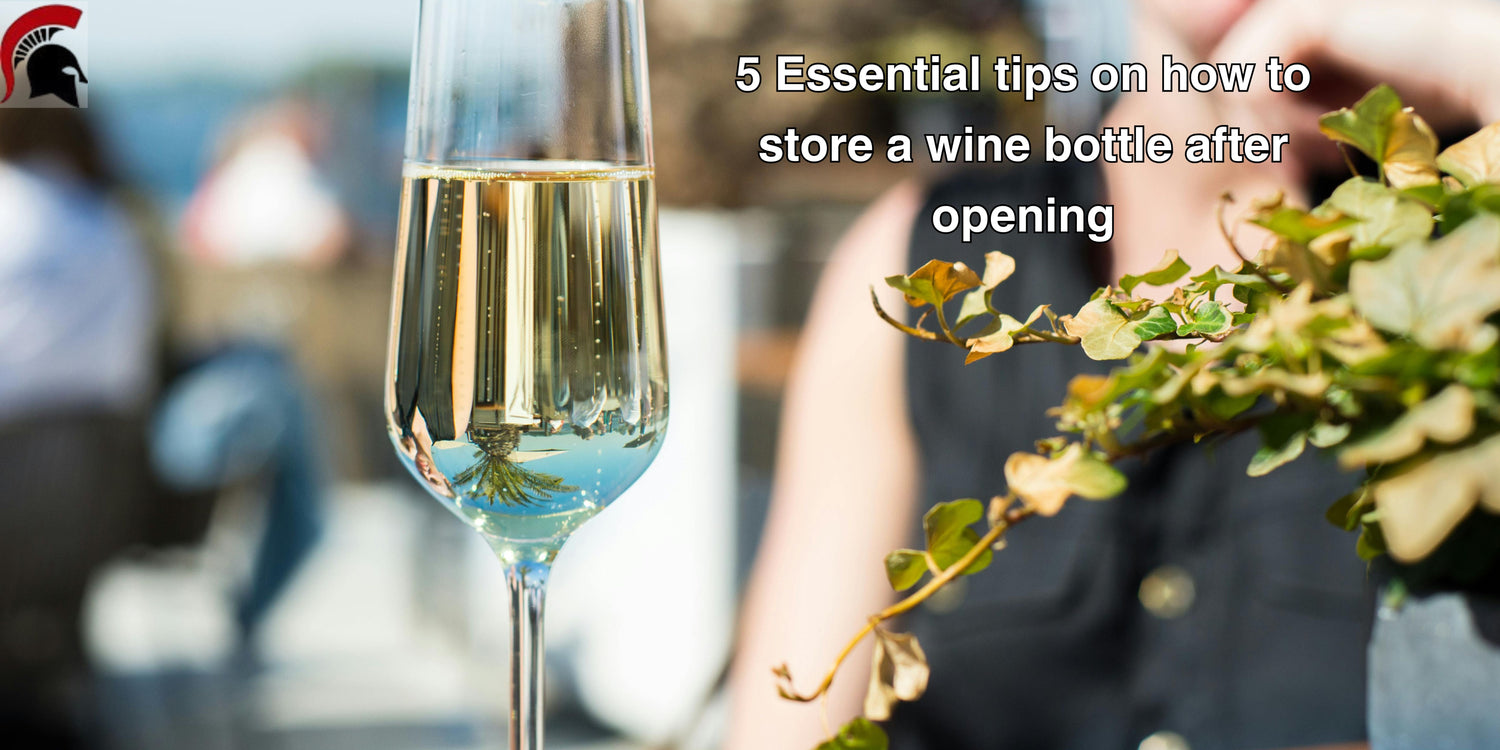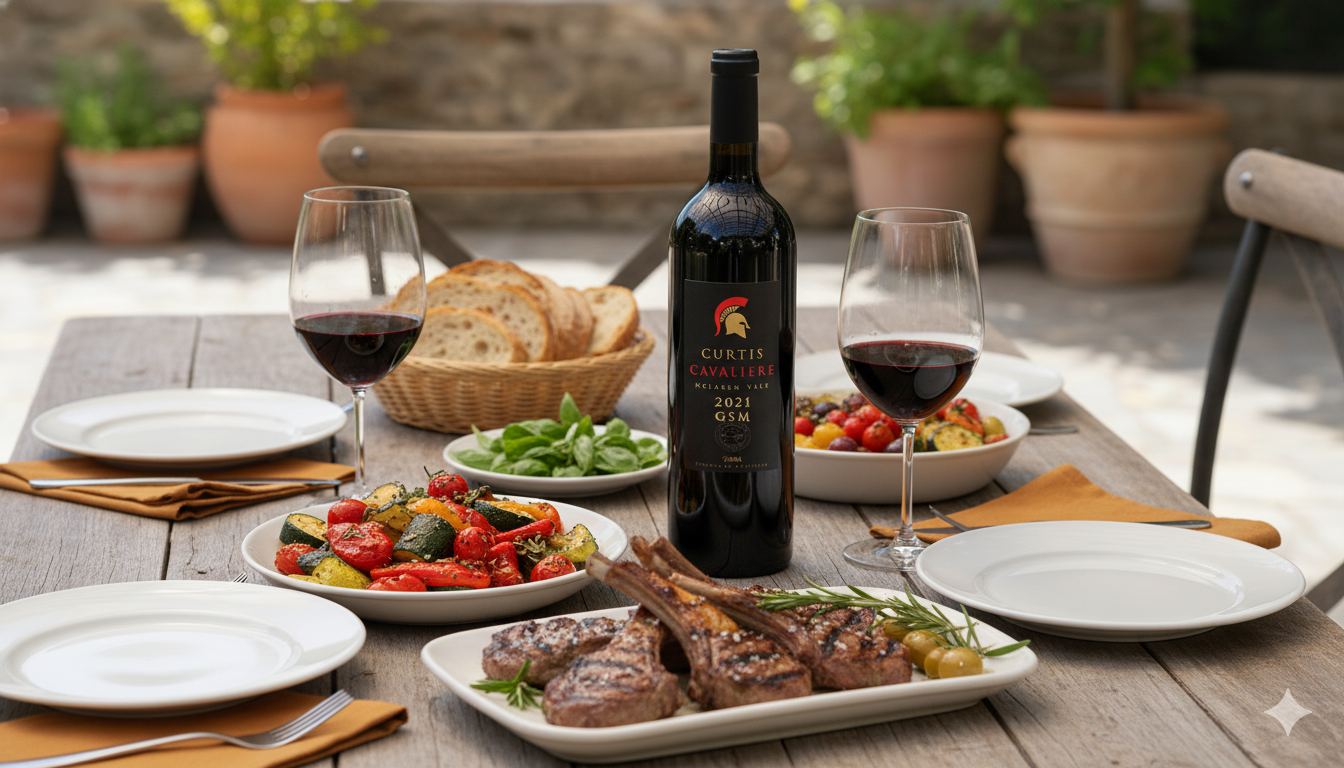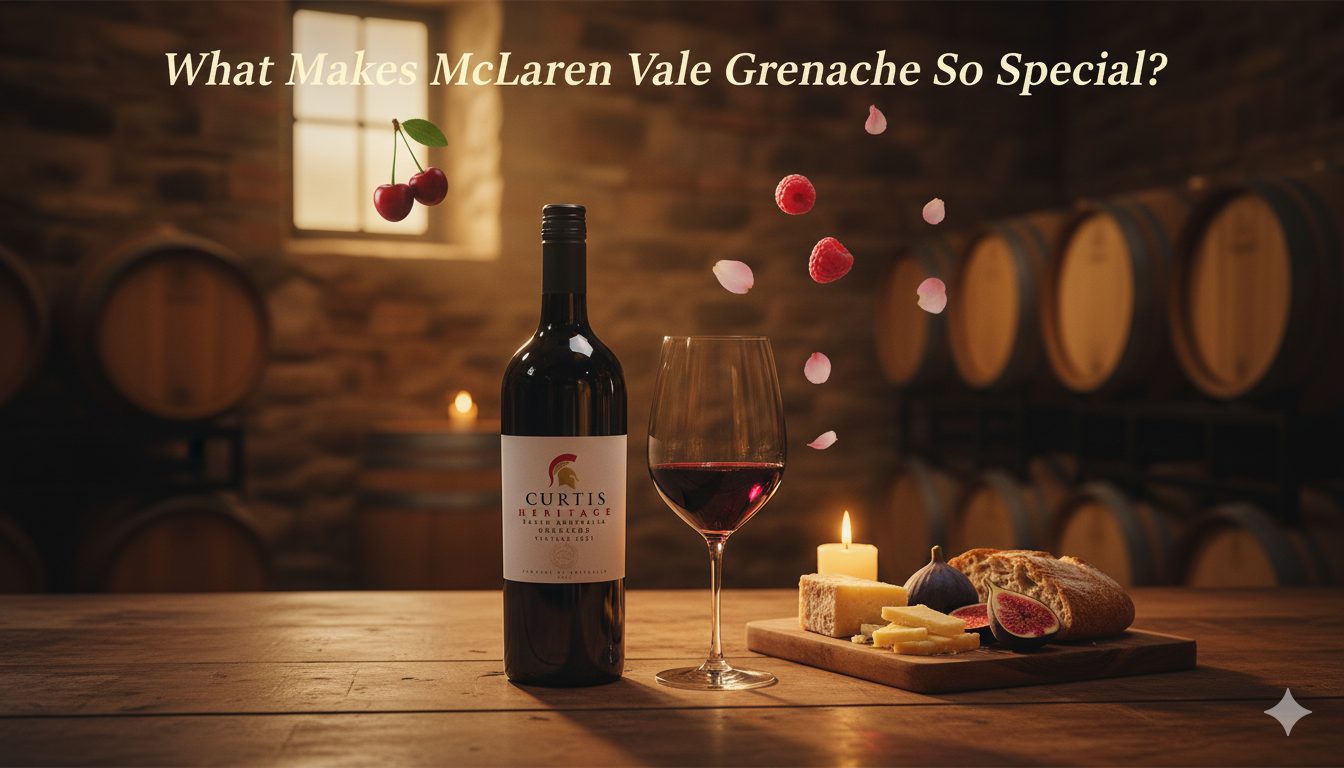Introduction :- How to store Wine bottle after opening
Opened a special bottle but couldn’t quite finish it yet ? Don’t know How to store wine bottle after opening? Don't let those precious drops go to waste. Whether it’s a bold Shiraz from McLaren Vale or a crisp white wine perfect for warm evenings, knowing how to store a wine bottle after opening can make all the difference to its flavour, aroma, and longevity.
Wine is a living product, and once opened, it begins to change. But with the right storage techniques, you can preserve its character for days—sometimes even longer. From keeping the bottle sealed correctly to storing it at the ideal temperature, a little care goes a long way.
At Curtis Family Vineyards, we’ve spent decades perfecting the art of winemaking right here in McLaren Vale, South Australia. We understand how important it is to honour every glass — from the first pour to the last sip.
In this guide, we’ll walk you through five essential tips to help you enjoy every opened bottle to the fullest. These simple but effective practices are trusted by wine lovers and sommeliers alike — and now, they’re yours to follow.
Understand the Shelf Life of Opened Wine
One of the most common questions wine lovers ask is: how long does wine last after opening? The short answer is — it depends on the type of wine and how it’s stored.
Once a bottle is opened, oxygen becomes both a friend and a foe. While it initially helps the wine "breathe" and develop its flavour, too much exposure causes the wine to oxidise, losing its aroma, taste, and balance over time.
General Shelf Life After Opening
Here’s a quick guide to how long different wines typically last once opened:
|
Wine Type |
Shelf Life (Opened) |
Best Storage Tips |
|
Red wine |
3–5 days |
Store in a cool, dark place with the bottle upright |
|
White & Rosé wine |
3–7 days |
Refrigerate with an airtight stopper |
|
Sparkling wine |
1–3 days |
Use a sparkling wine stopper and refrigerate promptly |
|
Fortified wine |
Up to 28 days |
Seal tightly and store in a dark, cool cupboard |
Factors That Affect an Open Bottle's Lifespan
Several elements influence how long your wine will stay fresh:
- Oxygen exposure: The more air in the bottle, the faster the wine will degrade.
- Light: Direct sunlight or artificial light can accelerate spoilage.
- Temperature: Warm temperatures speed up oxidation. Always store wine in a cool, stable environment.
- Storage position: Keep opened bottles upright to minimise surface area exposed to air.
Signs That Your Wine Has Gone Bad
Wondering if your opened wine is past its prime? Watch out for these tell-tale signs:
- A vinegar-like or sour aroma
- Noticeable change in colour (e.g., red wine turning brownish, white wine going golden or dull)
- A flat, dull, or sharp taste that lacks its original character
- Sparkling wine has lost its fizz and feels lifeless
At Curtis Family Vineyards, we believe great wine deserves to be enjoyed — from the first glass to the last. By understanding how long your opened wine lasts and spotting early signs of spoilage, you can confidently preserve the richness of each bottle. In the next section, we’ll explore the best tools to keep your wine tasting as good as when you first opened it.
Curtis Legion SA Merlot
Buy Now
Use the Right Wine Preserving Tools

If you’ve opened a beautiful bottle of Curtis Family Shiraz or Chardonnay, the last thing you want is to pour the rest down the sink a day or two later. That’s where the right wine preservation tools come in — helping to lock in flavour and freshness long after the cork is popped.
Proper preservation not only slows down oxidation but also ensures your wine still tastes just as good a few days later. Whether you're storing red Wine Shiraz , white or sparkling wine, here are some of the best wine preservation methods to consider:
Types of Wine Stoppers for Open Bottles
|
Preservation Tool |
How It Works |
Best For |
|
Vacuum stoppers |
Remove excess air from the bottle to reduce oxidation |
Everyday red or white wines |
|
Silicone/cork stoppers |
Create a basic seal; reusable and easy to use |
Short-term storage |
|
Argon gas wine savers |
Replace air with inert gas to protect wine from oxygen |
Premium wines or collectors |
|
Sparkling wine stoppers |
Clamp on to maintain carbonation and prevent leaks |
Champagne & sparkling wine |
Australian-Style Storage Tip
No matter which wine stopper you choose, always store your opened bottle away from direct sunlight and in a cool, temperature-stable room. Wine is sensitive to heat and light — especially during warm Aussie summers — so your pantry, wine fridge, or cellar is the safest bet.
Need a Recommendation?
If you're a frequent wine drinker or collector, investing in a reliable vacuum seal for wine or an argon gas preservation system is worth every cent. Some popular and highly rated tools include:
- Vacu Vin Wine Saver – Affordable and easy for daily use
- Coravin Wine Preservation System – Perfect for premium wines without pulling the cork
- Champagne Stopper by Avina – Keeps your bubbles fresh for longer
Preserving wine isn’t just about saving a bottle — it’s about respecting the craftsmanship that went into it. With the right tools and storage habits, you can continue to enjoy the story behind every sip, even days after opening.
Curtis Small Batch Riesling
Buy Now
Store Open Wine by Type Correctly

Not all wines are created equal — and neither are their storage needs. Whether you’ve uncorked a robust Shiraz or a chilled Sauvignon Blanc de blanc wine , the way you store your wine after opening will determine how well it holds up over the next few days.
So, how do you store red wine after opening? Should whites always be refrigerated? And what about bubbly?
Here’s what you need to know.
Red Wine
- Ideal Storage Temperature: 12–18°C
- Storage Tip: Store upright in a cool, dark cupboard or a wine fridge.
- Fridge or Not?: In warmer climates (like many parts of Australia), it’s okay to pop it in the fridge, especially if you don’t have a wine cellar. Just let it warm up to room temp before serving.
Why it matters: Heat and light are red wine’s enemies. Exposure can accelerate oxidation and dull the wine’s structure and character — especially for bold varietals like Shiraz vs. Cabernet Sauvignon.
White wine & Rosé Wine
- Ideal Storage Temperature: 7–10°C
- Storage Tip: Always store in the fridge after opening with a tight stopper.
- Fridge or Not?: Absolutely — refrigeration is a must.
Why it matters: Storing white wine after opening in the fridge helps maintain freshness and acidity. It’s especially important for delicate varietals like Riesling wine or Pinot Noir Wine or Queen of hearts rose wine that can spoil quickly once exposed to air.
Sparkling Wine
- Ideal Storage Temperature: 4–7°C
- Storage Tip: Use a sparkling wine stopper and refrigerate immediately.
- Fridge or Not?: Yes — and don’t delay.
Why it matters: Sparkling wines lose carbonation rapidly. A proper stopper helps preserve the fizz, but even then, aim to enjoy within 1–2 days of opening.
Quick Reference Table: Opened Wine Storage by Type
|
Wine Type |
Temp Range (°C) |
Refrigerate? |
Storage Notes |
|
Red Wine |
12–18°C |
Optional (Yes in summer) |
Store upright in a dark, cool spot |
|
White & Rosé Wine |
7–10°C |
Yes |
Always keep chilled after opening |
|
Sparkling Wine |
4–7°C |
Yes |
Use stopper to retain bubbles |
Knowing how to store wine bottle after opening based on the type of wine not only extends its drinkability but honours the winemaker’s vision. At Curtis Family Vineyards, we believe every bottle tells a story — and that story deserves to be enjoyed till the last drop.
Curtis Sparkling Pinot Noir Rosè
Buy Now
Avoid Common Wine Storage Mistakes

- Even seasoned wine lovers can unknowingly shorten the life of an open bottle with a few simple errors. Knowing what not to do with open wine is just as important as knowing how to store it well.
- From incorrect sealing to temperature slip-ups, these common missteps can lead to rapid oxidation, flavour loss, or even spoilage. Here’s what to avoid—and what the winemakers at Curtis Family Vineyards recommend instead.
Curtis Legion Chardonnay
Buy Now
Mistakes When Storing Wine (And How to Avoid Them)
|
Mistake |
Why It’s a Problem |
Better Practice |
|
Leaving the cork or cap off |
Exposes wine to air, leading to oxidation |
Always seal tightly with original cork or a wine stopper |
|
Storing wine upright for long periods |
Increases oxygen exposure to surface area |
Store upright only short term (2–3 days), or recline in cellar |
|
Exposing wine to sunlight or heat |
UV and high temperatures accelerate spoilage |
Store in a cool, dark place like a pantry or wine fridge |
|
Refrigerating red wine without letting it warm before serving |
Dulls aromas and flavours |
Remove from fridge ~30 mins before drinking |
|
Using non-airtight seals |
Allows slow oxygen leakage |
Use vacuum seal or argon gas system for better preservation |
Winemaker’s Note from Curtis Family Vineyards
- At Curtis Family Vineyards, preserving wine quality isn’t just something we do in the cellar—it’s a commitment that continues after the bottle leaves our hands.
- Our winemakers recommend treating open bottles with the same care used in production: protect it from oxygen, control storage temperature, and always use a proper seal. This not only helps maintain structure and aroma but honours the craftsmanship behind every vintage we release.
Invest in Smart Storage Solutions

- Whether you enjoy the occasional glass or open bottles more regularly, having the right wine storage tools can make all the difference. Thoughtful storage isn’t just about convenience — it’s about preserving flavour, structure, and the craftsmanship behind every bottle.
- From the best wine stoppers to eco-conscious gadgets, here’s how to protect your open wine the smart way.
Curtis Heritage Sparkling Blanc de Blanc
Buy Now
Top Smart Storage Tools for Wine Enthusiasts
|
Tool |
What It Does |
Why It’s Worth It |
|
Wine vacuum pump |
Removes air to slow oxidation |
Affordable, easy to use, ideal for reds and whites |
|
Reusable silicone wine stoppers |
Airtight seal to preserve freshness |
Eco-friendly and great for short-term storage |
|
Argon gas wine preserver |
Replaces oxygen with inert gas |
Ideal for premium bottles or collectors |
|
Dual-zone wine fridge |
Keeps different wines at ideal temps |
Long-term investment for serious wine lovers |
|
Eco-friendly wine savers |
Made from sustainable materials, often reusable |
Supports both wine and the planet |
Sustainable Storage Matters
Today’s wine lovers aren’t just thinking about what they drink — but how they store it. Opting for eco-friendly wine savers and reusables aligns with a more mindful lifestyle. At Curtis Family Vineyards, sustainability isn’t just a buzzword — it’s a principle we embrace, from the vineyard to your glass.
Store It Right, Drink It Better
Wine is a living, evolving product — and how you care for it after opening plays a huge role in your drinking experience. Investing in the right tools allows you to enjoy your wine the way it was meant to be savoured: full of life and flavour.
Explore the Curtis Family Vineyards range, where every bottle is crafted with care — and now, you know exactly how to make it last.
Wine Storage After Opening
- Even after learning the proper storage methods, many wine lovers still have lingering questions like, “Should I refrigerate red wine after opening?” or “Can I drink wine after 7 days?”
- Let’s put those doubts to rest — with insights straight from the Curtis Family Vineyards team, who’ve spent generations perfecting the art of wine preservation.
Should I Refrigerate Red Wine After Opening?
- Yes, in most cases. While red wine is traditionally enjoyed at room temperature, once opened, it benefits from refrigeration — especially in warm climates like Australia.
- "Cool, stable temperatures slow oxidation. For red wines, it’s fine to refrigerate after opening. Just allow it to warm slightly before serving," says Mark Curtis, Senior Winemaker at Curtis Family Vineyards.
- A short stint in the fridge can extend the life of your Shiraz or Cabernet by 3–5 days.
Can I Drink Wine After 7 Days?
It depends on the type of wine and how it’s been stored. Here’s a quick guide:
|
Wine Type |
Drinkable After 7 Days? |
Storage Conditions |
|
Red Wine |
Sometimes (if vacuum sealed & chilled) |
May lose complexity but still drinkable |
|
White & Rosé Wine |
Rarely |
Likely oxidised, especially if not well sealed |
|
Sparkling Wine |
Unlikely |
Loses fizz quickly, even with stopper |
If the wine smells sour, vinegary, or tastes flat — it’s probably time to pour it out.
Winemaker’s Assurance
- At Curtis Family Vineyards, we encourage Australian wine enjoyment without waste — but we also prioritise quality. Trust your senses. If a wine doesn’t smell or taste right, it's best not to risk it.
- With a little care (and the right tools), you can enjoy your opened bottle for days — confidently.
Conclusion
Wine is more than just a drink — it’s a crafted experience, shaped by soil, climate, and time. And once opened, how you care for your bottle can mean the difference between a memorable glass and a missed opportunity.
By following these 5 essential wine storage tips, you’re not just preserving your Award- winning wines — you're respecting the craftsmanship behind it. Whether it's a bold McLaren Vale Shiraz or a delicate white, storing your wine correctly helps maintain its flavour, aroma, and integrity — right to the very last sip.
“At Curtis Family Vineyards, we believe great wine deserves great care — from the vineyard to your glass,” says Mark Curtis, Senior Winemaker.
Ready to Enjoy Wine the Way It Was Meant to Be?
Explore our range of Curtis Family Vineyards wines, expertly crafted in McLaren Vale, South Australia.
Curtis Cavaliere McLaren Vale Shiraz
Buy Now
Curtis Cavaliere McLaren Vale Grenache Shiraz Mourvedre
Buy Now
Pasha McLaren Vale Shiraz
Buy Now
Frequently Asked Questions
What makes wine go bad after opening?
Once opened, oxygen is the main culprit that makes wine go bad. Exposure to air leads to oxidation, which dulls the flavour and aroma. Other factors like temperature fluctuations, light exposure, and not resealing the bottle properly also cause spoilage. That’s why knowing how to store a wine bottle after opening is essential to preserve its character and enjoy it for days.
How do you know if wine has gone bad?
Signs of spoiled wine include a vinegar-like smell, brownish colour (for whites), and a flat or sour taste. Sparkling wine loses its fizz, and red wines may taste overly sharp or musty. If the wine no longer resembles its original aroma or flavour, it’s likely oxidised or spoiled. Proper storage helps prevent this — always use airtight wine stoppers and keep the bottle in a cool, dark place after opening.
Can i drink opened wine after 2 weeks?
Generally, no — most opened wines won’t last that long. Red and white wines typically stay fresh for 3–5 days, while sparkling wines last just 1–3 days once opened. Drinking wine two weeks after opening can pose both taste and quality concerns. If you want your wine to last longer, it’s vital to learn how to store a wine bottle after opening using proper preservation tools.
When should you throw away wine after opening?
If your wine smells off, tastes sour, or appears cloudy, it’s time to toss it. Even the best wines can spoil quickly if not stored right. As a general rule:
- Sparkling wine: discard after 3 days
- White/rosé wine: 5–7 days
- Red wine: up to 5 days Using a wine fridge or vacuum stopper can help extend shelf life, but knowing when to throw away wine after opening ensures you never sip spoiled wine.
Why are wine bottles stored lying down?
Unopened wine bottles with corks are stored on their side to keep the cork moist. A dry cork can shrink and let in air, leading to oxidation. Although this doesn’t apply to screw-cap bottles, it’s still a traditional and space-efficient method. For opened bottles, however, always store upright to reduce air exposure inside the bottle — one of the golden rules of how to store a wine bottle after opening.
Can you drink 2 year old opened wine?
If a bottle has been opened and resealed, even if refrigerated, 2 years is far too long. Once air hits the wine, it starts to degrade quickly. The taste, aroma, and even colour will be significantly affected — and it could be unsafe to drink. Unless it’s a fortified wine (like port), opened wine should be consumed within a week. To avoid spoilage, always follow the correct methods on how to store a wine bottle after opening



Leave a comment
This site is protected by hCaptcha and the hCaptcha Privacy Policy and Terms of Service apply.